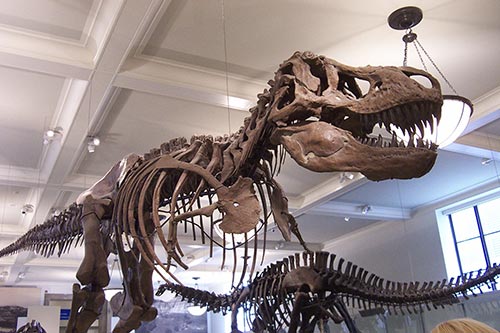Learn It Part 2
Let’s analyze the author’s purpose in the Newsela article Humans bringing Earth its 6th mass extinction, but can stop it Opens a new window. Read the article and see if you notice clues that reveal the author’s purpose or reasons for writing this text.
Examine the title of the article, “Humans bringing Earth its 6th mass extinction, but can stop it.” Does the title provide clues about the author’s purpose for writing this article? The title contains content about extinction but also indicates that the author may present concrete ways to stop the next extinction that may be facing Earth.
Let’s look at how the author’s purpose is further revealed as the text develops. Reread the first two paragraphs below:

This giant Tyrannosaurus rex skeleton shown at the American Museum of Natural History is a reminder of the period when dinosaurs roamed the earth. Many scientists believe that an asteroid caused a mass extinction that ended the dinosaur species.
Cataclysmic events drove the first five mass extinctions in Earth’s history. An asteroid ended the age of the dinosaurs. Volcanic eruptions may have caused the Great Dying, which wiped out much of the earth's marine life.
Altogether, the five mass extinctions caused 75 percent of the planet’s life to die out. The sixth mass extinction may now be beginning — and we're the cause of this one.
— Newsela, September 21, 2014
The author begins the article with the word “cataclysmic” to set the tone for the article and heighten the importance of our actions and their potential effect on our planet. Cataclysmic means an extremely violent action or event. The author continues to support this powerful word choice by providing key details about the causes of previous mass extinctions and then describes how those mass extinctions caused the majority of life on Earth to die out.
The author goes on to write, “The sixth mass extinction may now be beginning — and we're the cause of this one.” This sentence further emphasizes the harmful behavior of humans and profound impact it will have on the future of civilization. The author wants readers to believe that humans may be causing another mass extinction. By adding, “—and we’re the cause of this one” to the end of the sentence, the author emphasizes the point and transitions to the third paragraph, which describes how humans have contributed to the destruction of plant and animal habitats. The author’s word choice clearly reveals his/her purpose in explaining this topic: Humans are having a tremendous influence on the future of our planet.
The third paragraph reads:
Over the last several centuries we have constantly burned fossil fuels, like oil, coal and natural gas. In the process, we've changed the climate for other species. Humans use more than half of the planet’s unfrozen land for cities and logging or food. Our takeover has destroyed the natural habitats of animals and plants.
— Newsela, September 21, 2014
What key details in this paragraph provide clues to the author’s purpose? See if you can answer this question on your own, and then click Show Answer below.
The fourth paragraph reads:
Humans have existed for 200,000 years on Earth. Biologists and paleoecologists (who study ancient ecosystems) estimate that humans have driven roughly 1,000 species extinct. Early man helped hunt the biggest animals — woolly mammoths, giant kangaroos and giant sloths — to extinction. Since 1500, we have killed off at least 322 types of animals. The passenger pigeon, the Tasmanian tiger and, most recently, the baiji, a freshwater dolphin in China are all gone forever.
— Newsela, September 21, 2014
How does this paragraph support the author’s purpose? See if you can answer this question on your own, and then click Show Answer below.
Let’s examine the key ideas and details in the fourth paragraph more closely. Answer the questions in the activity below and see if you are correct.


